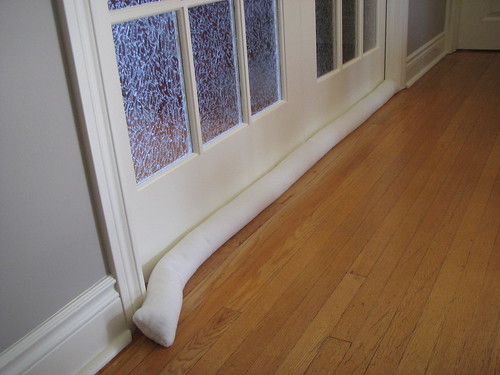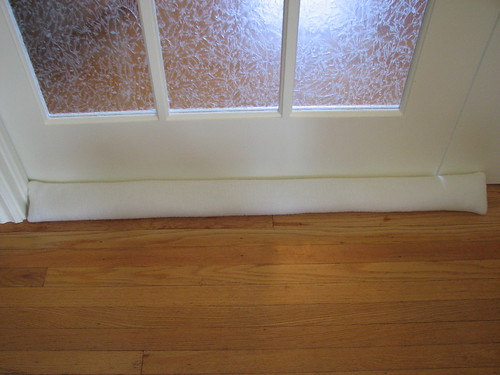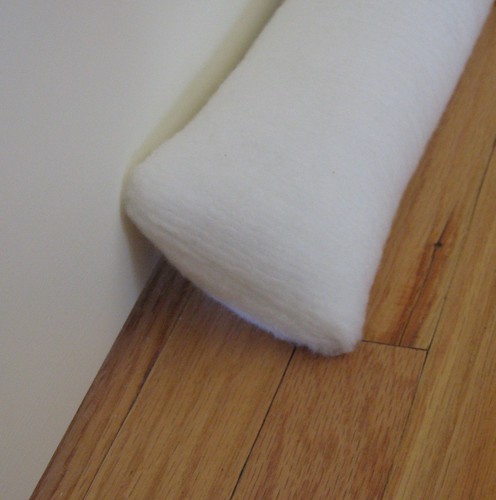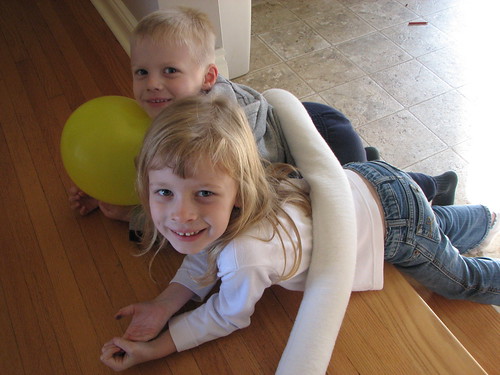A woman I know asked me to make these for her son who lives alone in a large, old, drafty farmhouse. It sounds like the heating bills can be a little tough to swallow. These will sit on the floor in front of the closed door to block any drafts that normally would come under the door.
They're just a tube of fabric, sewn closed at both ends. I wouldn't have picked this fabric, but that's what she gave me. It is some sort of knit fleece, with a fair bit of stretch. It was smooth on one side, but very fuzzy on the other. I wouldn't have picked white for something that sits on the floor, either, but it wasn't my call. I wanted to get rid of the stretch, so I underlined (that seems like a much too sophisticated word for this application, but I guess that is what I did) it with bleached muslin.
I haven't made this sort of thing before, so I did a little online research about them. My biggest question was what to fill it with. Some were just stuffed with polyfil, others used sand, kitty litter, beans or rice. I went with rice. I thought it would be most successful if it had some weight to it, but also could be molded a bit to fit tight against the bottom of the door. And I didn't want to it be expensive. I think it was a good choice. The second layer of fabric helped to keep it looking smooth.
One of these is really long - 75". It's for a set of double pocket doors like the one in the picture above, but bigger. The other is 39". I cut long rectangles, 8" wide by the length needed plus 2" for seam allowances. I sewed one end closed by machine when I sewed the long seam and sewed the other closed by hand after it was filled.
These had just been sitting on a chair in my sewing room, but the kids are having too much fun playing with these "snakes." I put them away because I'm afraid they're going to be all dirty before they get picked up and brought to their new home!
They're just a tube of fabric, sewn closed at both ends. I wouldn't have picked this fabric, but that's what she gave me. It is some sort of knit fleece, with a fair bit of stretch. It was smooth on one side, but very fuzzy on the other. I wouldn't have picked white for something that sits on the floor, either, but it wasn't my call. I wanted to get rid of the stretch, so I underlined (that seems like a much too sophisticated word for this application, but I guess that is what I did) it with bleached muslin.
I haven't made this sort of thing before, so I did a little online research about them. My biggest question was what to fill it with. Some were just stuffed with polyfil, others used sand, kitty litter, beans or rice. I went with rice. I thought it would be most successful if it had some weight to it, but also could be molded a bit to fit tight against the bottom of the door. And I didn't want to it be expensive. I think it was a good choice. The second layer of fabric helped to keep it looking smooth.
One of these is really long - 75". It's for a set of double pocket doors like the one in the picture above, but bigger. The other is 39". I cut long rectangles, 8" wide by the length needed plus 2" for seam allowances. I sewed one end closed by machine when I sewed the long seam and sewed the other closed by hand after it was filled.
These had just been sitting on a chair in my sewing room, but the kids are having too much fun playing with these "snakes." I put them away because I'm afraid they're going to be all dirty before they get picked up and brought to their new home!




Nice snakes!
ReplyDeletei made one for my sister-in-law for Christmas one year-- filled it with rice-- the mice, in her older house, liked it.
ReplyDelete